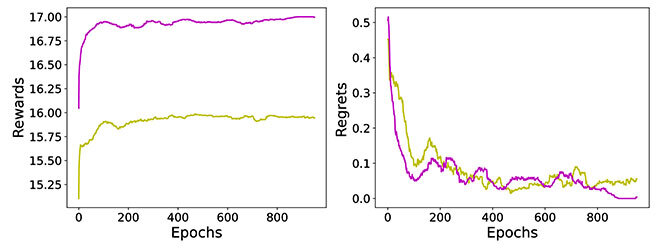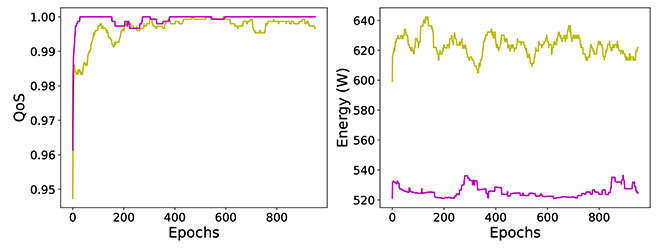Energy Efficiency in RAN Network Slicing

Purchased from Gettyimages. Copyright.
Beyond 5G and 6G networks are expected to support a wide range of services, with highly diverse requirements. In this respect, network slicing has been introduced as a promising paradigm for future mobile networks, supporting not only traditional mobile services, but also vertical industry services, with highly heterogeneous requirements. Along with its benefits, network slicing is introducing new challenges for the development of sustainable network operations. Yet, one of the main goals of operators is to offer diverse and seamless services, while ensuring energy efficiency. With this in mind, our aim is to shed light on the trade-offs between quality of service (QoS) and energy efficiency in network slicing, which can be achieved through different machine learning algorithms. The proposed solution provides approximately 11-14% energy efficiency improvement while ensuring that QoS remains at a similar level compared to a scenario where all slice instances are active.
Network Slicing in Beyond 5G and 6G: A Challenge
Network slicing (NS) has been proposed as a concept for separating a common underlying physical network into several mutually isolated, independently managed logical networks created on demand. While network slicing offers numerous benefits, it also presents several challenges, with higher energy consumption being one of the most critical. Recent studies have shown that the greatest amount of energy is consumed in the radio access network (RAN), accounting for approximately 60-80% of overall network energy use. One common approach to reducing energy consumption in RAN is using sleep mode for underutilized base stations. However, applying this technique directly in multi-services network slicing environments is more challenging and risky, due to distinct temporal traffic patterns exhibited by different slicing instances. In fact, a complete shut down or putting the entire base station into sleep mode could significantly impact the user QoS in particular slice instances. On the other hand, activating all slices all the time, so as to maximize QoS, significantly increases energy consumption. In practice, a balance between energy efficiency and user satisfaction is often sought to achieve the best overall results.

Figure 1: Solution architecture.
The Proposed Solution
In this work, we study the slice activation/deactivation problem at the level of individual base stations in the RAN. To solve the problem, we introduce two different approaches that rely on two decentralized machine learning techniques: Deep Contextual Multi-Armed Bandit (DCMAB) and Thompson Sampling Contextual Multi-Armed Bandit (Thompson-C) agents. Additionally, we introduce a dedicated slice instance called EcoSlice, which operates 24/7 using minimal resources and network functions, providing essential services continuously. Fig. 1 illustrates the architecture of the proposed solution. Each agent is presented with various configuration options for a base station, each associated with a reward. The agent’s task is to select the most appropriate configuration at each slice activation/deactivation interval (SADI) and redirect users to the EcoSlice if the specific slice instance required by the user is deactivated.

(a) Reward obtained for different β values.

(b) Regret obtained for different β values.
Figure 2: Reward and Regret obtained for different β values.
The performance of the proposed approaches is evaluated based on the real-world traffic dataset collected over the operational network of Orange, in the city of Poitiers, in France. We compare the performance of the proposed approaches with three counterparts: Thompson Sampling Non-Contextual Multi-Armed Bandit (Thompson-NC), AllActive (all slice instances are active) and Random (slice instances are randomly activated and deactivated). We use β as a trade-off parameter between energy consumption and QoS: a larger β gives more weight to the QoS. In Fig. 2, the DCMAB and Thompson-C agents exhibit better reward and regret trends than counterparts for different β values.

Figure 3: Energy improvement percentage of the different approaches over AllActive approach (left) and QoS of the different approaches, based on different β values.



Figure 4: Comparisons of Thompson-C (with EcoSlice) Vs Thompson-C (without EcoSlice).
Fig. 4 presents a comparison of the performance of the Thompson-C agent with and without an
EcoSlice in terms of reward, regret, QoS, and energy utilization. Results show that Thompson-C performs better in the presence of EcoSlice than in its absence.
Conclusion
Harnessing machine learning techniques to develop energy-efficient solutions in network slicing has shown great potential for creating sustainable and eco-friendly next-generation networks. In this work, we focus on the slice activation/deactivation problem to further enhance energy efficiency in RAN slicing. To solve the problem, we introduce two different approaches that rely on decentralized machine learning agents. The proposed approaches offer trade-offs between energy consumption and user QoS.
Additional Information
For more information on the contribution, please refer to the full article: https://ieeexplore.ieee.org/abstract/document/10223377



